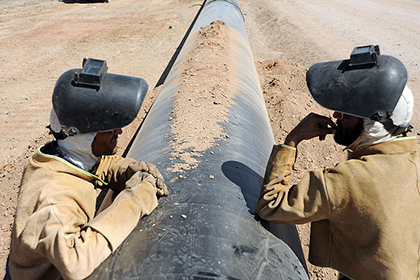District 7 of Gas Transmission Operations affiliated with National Iranian Gas Company (NIGC) covers mainly cold regions, including Markazi, Lorestan, Kurdestan, Kermanshah, Ilam, Hamedan and parts of West Azarbaijan and Qazvin provinces.
Furthermore, District 7 is a major source of gas export to Iraq. This tough task is being fulfilled owing to competent manpower and the capacity of Naftshahr metering stations in the best possible manner. In the near future, a new metering station is to become available in Qasr-e Shirin.
District 7 covers 4,821 kilometers of pipeline, accounting for 13% of Iran’s total pipe length. Once new projects become operational, the total length will reach 5,500 kilometers.
As a strategic area of Iran Gas Transmission Company(IGTC), District 7 enjoys the highest growth and development rate.
The pipelines are extended on 150,000 square kilometers with the highest number of city gate stations (CGS). There are also 9 gas compressors under construction on the Iran Gas Trunkline 6 and IGAT-9.
Iran Petroleum has interviewed Amin Ebadi, manager of District 7 gas transmission operations.
Over recent years, we have witnessed significant development in provincial gas transmission networks covered by District 7. Have you had any macro-planning?
The startup of production centers at Khorramabad-Sanandaj-Kuhdasht-Ilam pipeline and equipping with center with necessary machinery are among measures taken over recent years for this district.
How much gas has been transmitted totally over nine months and how much pigging and leak detection has been done?
During the first three quarters of the current calendar year (ending on 21 March 2020), more than 25 bcm of gas was transmitted while 3,850 kilometers of pigging and 2,300 kilometers of leak detection has been done.
What have you needed to develop cooperation with domestic companies for supplying equipment?
This operating district has always been ahead of others for holding tender bids independently. Widespread activities have been done, including meetings or logistic operations for identifying the potential of domestic manufacturing companies, receiving their CVs and placing the domestic manufacturers on the vendor list, introducing domestic knowledge-based companies to engineering and operation division or the exchange of information and transfer of knowhow, prioritizing domestic manufacturers for registering purchase orders, distributing polling forms among domestic companies and gathering their views and suggestions, identifying newly-established companies that remain unknown and holding meetings for presentation.
What was specifically done this calendar year in support of domestic companies?
All domestically-sourced necessary commodities and items, including spare parts for turbocompressors, filters and accessory equipment, have been purchased from domestic manufacturers.
What activities have been done with regard to upgrading equipment and software for District 7?
In communications and information technology, state-of-the-art technology has been used in creating ICT infrastructure. The database and network infrastructure in District 7 is among the most updated networks at NIGC. Furthermore, the BPMS software has been used to develop applied software in the district.
Are you cooperating specifically with knowledge-based companies and parks of science and technology?
Yes, we cooperate with scientific and research centers. We are specifically working with the Hamedan Park of Science and Technology in research affairs. We have good contacts with Bu Ali Sina University, Hamedan University of Technology, Hamedan University of Medical Sciences and the Hamedan branch of Islamic Azad University. We also plan effective interaction with Iran University of Science and Technology, as well as universities that have won IGTC’s satisfaction.
A new chapter has opened in self-sufficiency for IGTC. What has been the case with District 7?
In this district, domestic manufacturing and self-sufficiency mainly pertain to the manufacturing and reconstruction of MAN turbine parts. So far, more than 600 spare parts of the MAN turbine have been manufactured by domestic knowledge-based companies. More than 100 items have been also manufactured domestically for gas compressor and gas metering stations as well as gas exports.
The file of overhauls for the current calendar year is closed, isn’t it? Have any specific measures been taken to boost the sustainability of gas supply?
Yes, the overhaul is done. The most important measures include the overhaul of the MAN gas compressors in Section A and Section C of the Arak gas compressor installations, overhaul of dry gas seal in the Famanin and Bijar gas compressor stations, making Cold Section parts for MAN gas turbines, as well as overhaul of gas coolers in Famanin and Bijar. Furthermore, for the purpose of increasing the gas transmission network sustainability and changing the pipelines, maximum gas supply to western provinces is assured through IGAT-6.
Anything else you would like to add for conclusion?
District 7 has effective and competent staff serving the nation. My colleagues at the operation and logistics sections are using their expertise and experience to fulfil their mission of sustainable gas transmission to western provinces successfully. In order to demonstrate the endeavor and hardships of our colleagues who sometimes need to work in remote and mountainous areas or riverbeds, for the first time a permanent festival of Me and Work was designed, asking the staff to paint the image of their operations or send us relevant photos. So far, more than 100 photos have been sent to the secretariat of the festival for a competition.
 Iran Energy News Oil, Gas, Petrochemical and Energy Field Specialized Channel
Iran Energy News Oil, Gas, Petrochemical and Energy Field Specialized Channel




